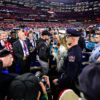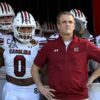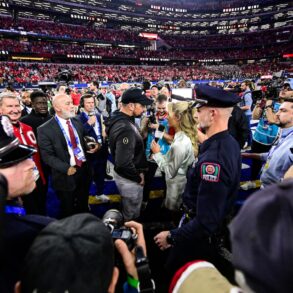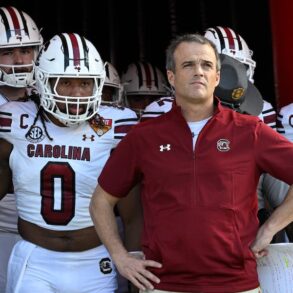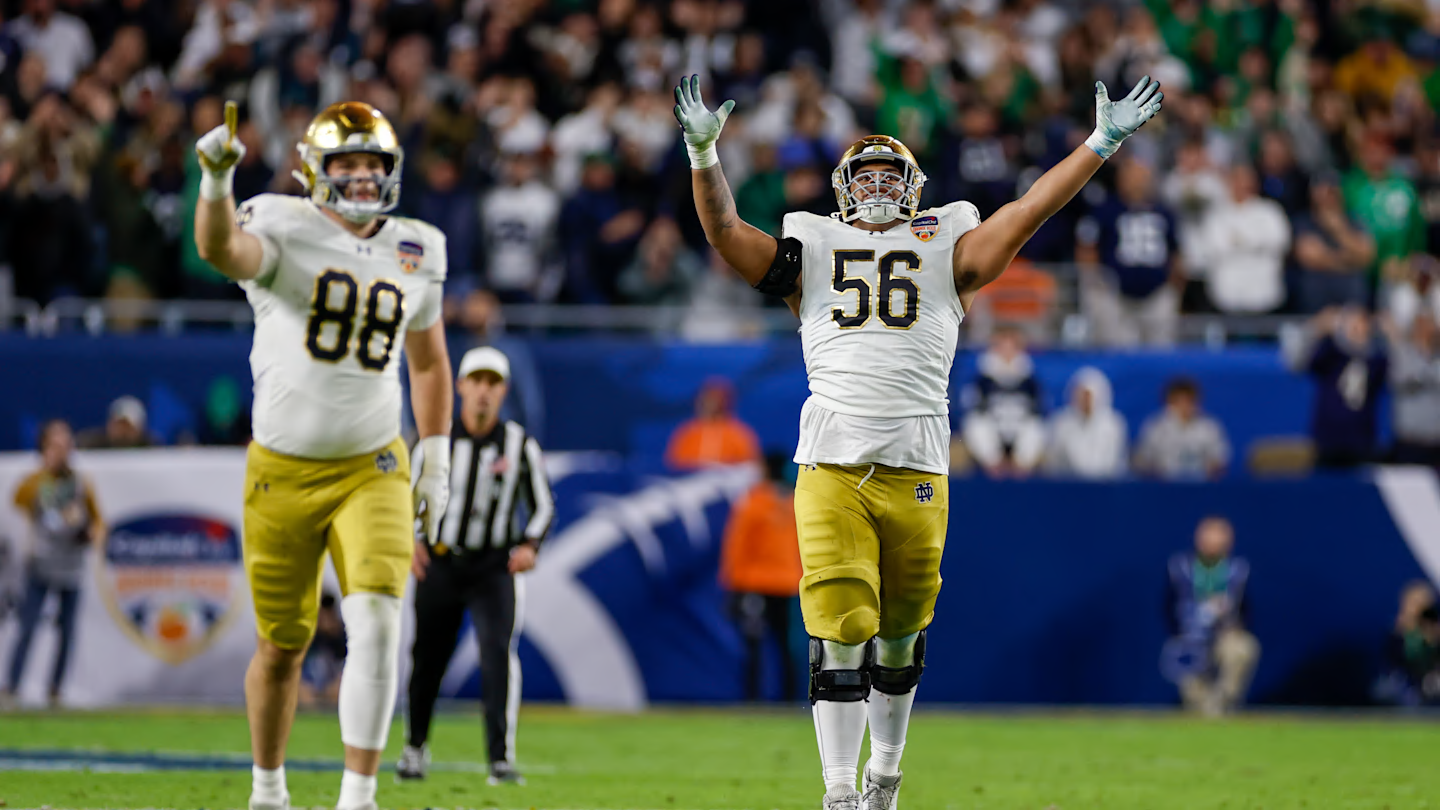
At one of the Notre Dame Fighting Irish’s first preseason practices in early August, sophomore left tackle Charles Jagusah went through drills with his teammates just like he had done numerous times.
He stuck his arm out, another player pulled it at an awkward angle and the 6′ 7″, 328-pound offensive lineman went down in a heap with a pectoral injury.
“It was just a weird play in practice. Didn’t really see a guy coming, put my arm out. Then how it happened, I don’t know,” Jagusah says, noting the practice didn’t even feature full pads. “There’s not much you can do about it. So you just move forward.”
Jagusah was supposedly lost for the season. It was a massive blow to Notre Dame’s hopes before the season was underway.
However, one of the longest seasons in college football history actually became an asset. The 16-game march to Atlanta for the College Football Playoff national championship this week allowed a pathway for Jagusah to return.
He began practicing ahead of the team’s first-round playoff game against the Indiana Hoosiers. He donned pads and took limited contact prior to the Sugar Bowl quarterfinal. Against the Penn State Nittany Lions in the Orange Bowl semifinal, Jagusah made it back between the lines, filling in at guard and contributing to the team’s second-half surge.
“I think before the season, you spend some time really coming up with a great plan for after Week 12. For us, we knew there was no chance of us having a first-round bye, so we also knew that we weren’t going to play in a conference championship, so we had to maximize those two weeks,” Notre Dame coach Marcus Freeman said. “You had to have a big-picture approach to the next four opportunities, even though you didn’t know if they were guaranteed or not. I think each week you kind of get with your sports performance team and have some discussions and make a plan for what you feel your team needs physically and mentally for that week. It’s worked pretty well for us.”
Jagusah’s return after a long layoff is one side of the coin to this slog of a season that starts as early as July 24 for those with fall camp kicking off ahead of a Week 0 game. Most teams are at full go in early August and play through at least Thanksgiving. This season’s calendar added an additional wrinkle of two off weeks as a result of when the holidays fell to provide an even longer run than normal.
Roughly two-thirds of FBS make preparations for a postseason game in December, and a select group of 12 eye a deep playoff run after being seeded into the playoff field by the selection committee.
Notre Dame and its title game opponent, the Ohio State Buckeyes, will play 16 games. Neither team played in a Week 0 game nor a conference championship game, which could have extended the season further. That’s a lot for anybody in the sport and a big reason why college football programs have adjusted their normal routines as the weather has grown colder as the season progresses.
“It alters how you approach the physicality of what you do towards the end of the season of course,” Irish offensive coordinator Mike Denbrock said. “You can’t have the same practice Week 16 as you had the first day of training camp. It’s not quite as physical as it was maybe in the beginning. But you have to be able to balance the work that you need with limiting some of the physicality but still get the speed as much as you possibly can. It’s a little bit of a challenge, but we’ve got really smart kids, and they understand what we’re after and how to get it.”
Jagusah, who will make his first start of the season in the national title game, saw action in the Orange Bowl only as the result of starting guard Rocco Spindler’s ankle injury. Spindler is set to return against the Buckeyes. Left tackle Anthonie Knapp (ankle) is out for the title game.
Those are just a few of the injuries suffered during the playoff. On the offensive line, Irish starting center Ashton Craig tore his left ACL against the Purdue Boilermarkers midseason and Buckeyes counterpart Seth McLaughlin suffered a torn Achilles during a November practice.
The injuries were blows, no doubt, but could have been an even bigger issue had the sprawling support and training staffs not ramped up intensity as the games grew more meaningful. The coaches, too, played a role, in leaning on years of sports science and knowing when to dial things up or back as needed.
“We started at the end of the season and worked our way back. So there was a lot of things that we put in place to try to help with that,” Ohio State coach Ryan Day said. “I don’t think it’s a secret anymore, but one of the things in particular was on offense we didn’t play as fast to cut down on the number of overall snaps to make sure our depth was where it needed to be, the way we practiced, the sports science of it all. There was a lot of things we took into consideration knowing that this would be the run we would look to go on.”
Fewer snaps played during practice and games helped the Buckeyes enter Monday night as healthy as they have been all year long. It’s a quirk that comes down to both foresight and a little bit of luck.
“Every season is unique on its own. But when you play such a long schedule, it’s 16 games at this point, it’s really grueling. It’s taxing on the body. It’s taxing mentally, emotionally,” sixth-year Notre Dame linebacker Jack Kiser said. “But I think when you’re with such a great group of guys who are all doing the same thing, so we’re all in it for the right reasons, it’s just something you do, right? So you don’t even really realize the grind of a season.”
Perhaps not in the moment, but there will come a time for that as the sport grapples with a former one-semester run expanding well past its traditional end date on New Year’s Day.
The good news, for at least one team who has made it all the way to the end, is the confetti falling and that big, golden trophy tend to cure a lot of the aches, pain and hurt built up over the course of the last six months.
This post was originally published on this site be sure to check out more of their content.


